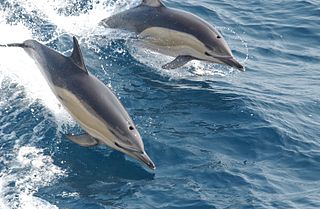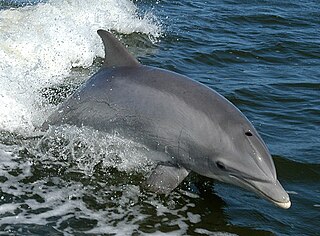
Bottlenose dolphins are aquatic mammals in the genus Tursiops. They are the most common members of the family Delphinidae, the family of oceanic dolphins. Molecular studies show the genus definitively contains two species: the common bottlenose dolphin and the Indo-Pacific bottlenose dolphin. Others, like the Burrunan dolphin, may be alternately considered their own species or be subspecies of T. aduncus. Bottlenose dolphins inhabit warm and temperate seas worldwide, being found everywhere except for the Arctic and Antarctic Circle regions. Their name derives from the Latin tursio (dolphin) and truncatus for their characteristic truncated teeth.

The common dolphin is the most abundant cetacean in the world, with a global population of about six million. Despite this fact and its vernacular name, the common dolphin is not thought of as the archetypal dolphin, with that distinction belonging to the bottlenose dolphin due to its popular appearances in aquaria and the media. However, the common dolphin is often depicted in Ancient Greek and Roman art and culture, most notably in a mural painted by the Greek Minoan civilization.

The Indo-Pacific bottlenose dolphin is a species of bottlenose dolphin. This dolphin grows to 2.6 m (8.5 ft) long, and weighs up to 230 kg (510 lb). It lives in the waters around India, northern Australia, South China, the Red Sea, and the eastern coast of Africa. Its back is dark grey and its belly is lighter grey or nearly white with grey spots.

The common bottlenose dolphin or Atlantic bottlenose dolphin is the most well-known species of the family Delphinidae.

Cetacean surfacing behaviour or breaching is a group of behaviours demonstrated by the Cetacea infraorder when they come to the water's surface to breathe. Time intervals between surfacing can vary depending on the species, surfacing style or the purpose of the dive; some species have been known to dive for up to 85 minutes at a time when hunting, and dives in excess of three hours have been observed in Cuvier's beaked whale under extreme circumstances.

The Bottlenose Dolphin Research Institute (BDRI) is a research and educational centre dedicated to the understanding and conservation of cetaceans and the marine environment in which they live. The Institute's BDRI centre was founded by the biologist Bruno Díaz López in Sardinia, Italy in 2005. In 2014, the BDRI opened a new facility in Galicia, Spain.

The Burrunan dolphin is a subspecies or potential species of bottlenose dolphin found in parts of Victoria, Australia first described in 2011. Its exact taxonomy is debated: numerous studies support it as being a separate species within the genus Tursiops and occupying a basal position within the genus, but other phylogenetic studies using different methodologies indicate that it is a subspecies of the Indo-Pacific bottlenose dolphin. The Burrunan dolphin is not currently recognized as a species by the Society for Marine Mammalogy or American Society of Mammalogists, which cites problematic methodology in the original study proposing species status and recommends further research.

Bernd Gerhard Würsig is an educator and researcher who works mainly on aspects of behavior and behavioral ecology of whales and dolphins. Much of his early work was done in close collaboration with his wife Melany Ann Würsig, and they have published numerous manuscripts and books together. He is now Professor Emeritus at Texas A&M University, teaching only occasionally but still involved with graduate student and other research. He is especially active with problems and potential solutions concerning Indo-Pacific humpback dolphins, Sousa chinensis, in and surrounding waters of Hong Kong.
Professor Helene Denise Marsh is an Australian scientist who has provided research in the field of Environmental Science, more specifically Zoology and Ecology. The focal point of her research has been the biology of dugongs, with particular foci in the areas of population ecology, history, reproduction, diet, and movements. She is the Dean of Graduate Research Studies and the Professor of Environmental Science at James Cook University in Queensland, Australia, and also a Distinguished Professor in the College of Marine and Environmental Science. Marsh is also a program leader for the Marine and Tropical Research Science Facility. In 2015 she was elected a Fellow of both the Australian Academy of Science (FAA), and the Australian Academy of Technological Sciences and Engineering (FTSE). She was appointed Officer of the Order of Australia (AO) in the 2021 Australia Day Honours.

Dianne Heather Brunton is a New Zealand ecologist, and head of the Institute of Natural and Computational Sciences at Massey University. Her research area is the behaviour and cultural evolution of animal communication, especially bird song in southern hemisphere species such as the New Zealand bellbird.
The Shaw Institute, formerly the Marine & Environmental Research Institute, is a 501(c)(3) nonprofit scientific research organization based in Blue Hill, Maine and New York City. The Institute conducts research into ocean pollution, flame retardants, microplastics and plastic pollution, sentinel species and climate change.
Elissa Zanna Cameron is a New Zealand wildlife biologist whose research includes animal behaviour, ecology and conservation biology.
Karen Ann Stockin is a New Zealand academic marine ecologist, and as of 2021 is a full professor at Massey University. Her research focuses on animal welfare and the impacts of human activities on cetacean populations, including tourism effects, and persistent marine contaminants.

Posidonia australis seagrass meadows of the Manning-Hawkesbury ecoregion is an endangered ecological community, listed under the EPBC Act of the Commonwealth of Australia on 7 May 2015









